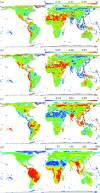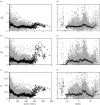Spatial turnover in the global avifauna - PubMed (original) (raw)
Comparative Study
Spatial turnover in the global avifauna
Kevin J Gaston et al. Proc Biol Sci. 2007.
Abstract
Despite its wide implications for many ecological issues, the global pattern of spatial turnover in the occurrence of species has been little studied, unlike the global pattern of species richness. Here, using a database on the breeding distributions of birds, we present the first global maps of variation in spatial turnover for an entire taxonomic class, a pattern that has to date remained largely a matter of conjecture, based on theoretical expectations and extrapolation of inconsistent patterns from different biogeographic realms. We use these maps to test four predictions from niche theory as to the form that this variation should take, namely that turnover should increase with species richness, towards lower latitudes, and with the steepness of environmental gradients and that variation in turnover is determined principally by rare (restricted) species. Contrary to prediction, we show that turnover is high both in areas of extremely low and high species richness, does not increase strongly towards the tropics, and is related both to average environmental conditions and spatial variation in those conditions. These results are closely associated with a further important and novel finding, namely that global patterns of spatial turnover are driven principally by widespread species rather than the restricted ones. This complements recent demonstrations that spatial patterns of species richness are also driven principally by widespread species, and thus provides an important contribution towards a unified model of how terrestrial biodiversity varies both within and between the Earth's major land masses.
Figures
Figure 1
Global distributions of species gain and loss between neighbouring grid cells. The mean number of species (a,d) shared (matching component a), (b,e) gained (matching component b) and (c,f) lost (matching component c) in comparisons between each focal grid cell and its adjacent neighbours, expressed as raw numbers (a_–_c) and as a proportion of the total number of species in the focal cell. The colour scales are histogram equalized and the quartile values are indicated.
Figure 2
Global distributions of spatial turnover indices and species richness. (a) _β_w, (b) _β_sim, (c) _β_j and (d) species richness. The colour scales are histogram equalized and the quartile values are indicated.
Figure 3
Relationships of three indices of spatial turnover with species richness and latitude. Associations are shown for species richness (a_–_c), and latitude (d_–_f), for (a,d) square-root transformed _β_w, (b,e) _β_sim and (c,f) _β_j. The range of values at each latitude and species richness, respectively, is shown in grey and the latitudinal or species richness medians are plotted as open circles. In order to show these relationships more clearly, the graph for _β_w is truncated at 3 and that of _β_sim at 0.3.The omitted values constitute 1.8% (_β_w) and 0.7% (_β_sim) of the dataset: all have low species richness (max=186, median=4) but cover a wide range of latitudes. Southern latitudes are indicated as negative, northern ones as positive.
Similar articles
- Spatial scale, abundance and the species-energy relationship in British birds.
Evans KL, Newson SE, Storch D, Greenwood JJ, Gaston KJ. Evans KL, et al. J Anim Ecol. 2008 Mar;77(2):395-405. doi: 10.1111/j.1365-2656.2007.01332.x. Epub 2007 Nov 13. J Anim Ecol. 2008. PMID: 18005031 - Global patterns of geographic range size in birds.
Orme CD, Davies RG, Olson VA, Thomas GH, Ding TS, Rasmussen PC, Ridgely RS, Stattersfield AJ, Bennett PM, Owens IP, Blackburn TM, Gaston KJ. Orme CD, et al. PLoS Biol. 2006 Jul;4(7):e208. doi: 10.1371/journal.pbio.0040208. PLoS Biol. 2006. PMID: 16774453 Free PMC article. - Energy, range dynamics and global species richness patterns: reconciling mid-domain effects and environmental determinants of avian diversity.
Storch D, Davies RG, Zajícek S, Orme CD, Olson V, Thomas GH, Ding TS, Rasmussen PC, Ridgely RS, Bennett PM, Blackburn TM, Owens IP, Gaston KJ. Storch D, et al. Ecol Lett. 2006 Dec;9(12):1308-20. doi: 10.1111/j.1461-0248.2006.00984.x. Ecol Lett. 2006. PMID: 17118005 - A review of the relationships between human population density and biodiversity.
Luck GW. Luck GW. Biol Rev Camb Philos Soc. 2007 Nov;82(4):607-45. doi: 10.1111/j.1469-185X.2007.00028.x. Biol Rev Camb Philos Soc. 2007. PMID: 17944620 Review. - Parasite biodiversity revisited: frontiers and constraints.
Poulin R. Poulin R. Int J Parasitol. 2014 Aug;44(9):581-9. doi: 10.1016/j.ijpara.2014.02.003. Epub 2014 Mar 6. Int J Parasitol. 2014. PMID: 24607559 Review.
Cited by
- Idiosyncratic patterns of local species richness and turnover define global biodiversity hotspots.
Sonne J, Rahbek C. Sonne J, et al. Proc Natl Acad Sci U S A. 2024 Jan 16;121(3):e2313106121. doi: 10.1073/pnas.2313106121. Epub 2024 Jan 8. Proc Natl Acad Sci U S A. 2024. PMID: 38190521 Free PMC article. - Conservation priorities for terrestrial mammals in Dobrogea Region, Romania.
Miu IV, Chisamera GB, Popescu VD, Iosif R, Nita A, Manolache S, Gavril VD, Cobzaru I, Rozylowicz L. Miu IV, et al. Zookeys. 2018 Oct 23;(792):133-158. doi: 10.3897/zookeys.792.25314. eCollection 2018. Zookeys. 2018. PMID: 30402034 Free PMC article. - Quantifying phytogeographical regions of Australia using geospatial turnover in species composition.
González-Orozco CE, Ebach MC, Laffan S, Thornhill AH, Knerr NJ, Schmidt-Lebuhn AN, Cargill CC, Clements M, Nagalingum NS, Mishler BD, Miller JT. González-Orozco CE, et al. PLoS One. 2014 Mar 21;9(3):e92558. doi: 10.1371/journal.pone.0092558. eCollection 2014. PLoS One. 2014. PMID: 24658356 Free PMC article. - Species richness and range size of the terrestrial mammals of the world: biological signal within mathematical constraints.
Soberón J, Ceballos G. Soberón J, et al. PLoS One. 2011 May 6;6(5):e19359. doi: 10.1371/journal.pone.0019359. PLoS One. 2011. PMID: 21573112 Free PMC article. - Isolated alpine habitats reveal disparate ecological drivers of taxonomic and functional beta-diversity of small mammal assemblages.
Song WY, Li XY, Chen ZZ, Li Q, Onditi KO, He SW, Jiang XL. Song WY, et al. Zool Res. 2020 Nov 18;41(6):670-683. doi: 10.24272/j.issn.2095-8137.2020.085. Zool Res. 2020. PMID: 32918407 Free PMC article.
References
- Blackburn T.M, Gaston K.J. The distribution of bird species in the New World: patterns in species turnover. Oikos. 1996;77:146–152. doi:10.2307/3545594 - DOI
- Bonn A, Storch D, Gaston K.J. Structure of the species–energy relationship. Proc. R. Soc. B. 2004;271:1685–1691. doi:10.1098/rspb.2004.2745 - DOI - PMC - PubMed
- Brown J.H. On the relationship between abundance and distribution of species. Am. Nat. 1984;124:255–279. doi:10.1086/284267 - DOI
- Condit R, et al. Beta-diversity in tropical forest trees. Science. 2002;295:666–669. doi:10.1126/science.1066854 - DOI - PubMed
- Evans K.L, James N.A, Gaston K.J. Abundance, species richness and energy availability in the North American avifauna. Glob. Ecol. Biogeogr. 2006;15:372–385. doi:10.1111/j.1466-822X.2006.00228.x - DOI
Publication types
MeSH terms
LinkOut - more resources
Full Text Sources


